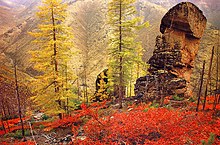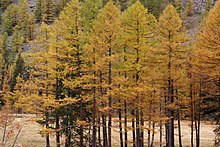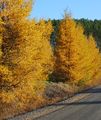| Larch | |
|---|---|

| |
| Larix lyallii in autumn near Lake Olrun in Washington State, US | |
| Scientific classification | |
| Kingdom: | Plantae |
| Clade: | Tracheophytes |
| Clade: | Gymnospermae |
| Division: | Pinophyta |
| Class: | Pinopsida |
| Order: | Pinales |
| Family: | Pinaceae |
| Subfamily: | Laricoideae |
| Genus: | Larix Mill. |
| Type species | |
| Larix decidua Mill. | |
| Species | |
|
About 10–11; see text | |
Larches are deciduous conifers in the genus Larix, of the family Pinaceae (subfamily Laricoideae). Growing from 20 to 45 metres (65 to 150 feet) tall, they are native to the cooler regions of the northern hemisphere, where they are found in lowland forests in the high latitudes, and high in mountains further south. Larches are among the dominant plants in the boreal forests of Siberia and Canada. Although they are conifers, larches are deciduous trees that lose their needles in the autumn.
Etymology
The English name larch ultimately derives from the Latin "larigna", named after the ancient settlement of Larignum. The story of its naming was preserved by Vitruvius:
It is worth while to know how this wood was discovered. The divine Caesar, being with his army in the neighbourhood of the Alps, and having ordered the towns to furnish supplies, the inhabitants of a fortified stronghold there, called Larignum, trusting in the natural strength of their defences, refused to obey his command. So the general ordered his forces to the assault. In front of the gate of this stronghold there was a tower, made of beams of this wood laid in alternating directions at right angles to each other, like a funeral pyre, and built high, so that they could drive off an attacking party by throwing stakes and stones from the top. When it was observed that they had no other missiles than stakes, and that these could not be hurled very far from the wall on account of the weight, orders were given to approach and to throw bundles of brushwood and lighted torches at this outwork. These the soldiers soon got together.
The flames soon kindled the brushwood which lay about that wooden structure and, rising towards heaven, made everybody think that the whole pile had fallen. But when the fire had burned itself out and subsided, and the tower appeared to view entirely uninjured, Caesar in amazement gave orders that they should be surrounded with a palisade, built beyond the range of missiles. So the townspeople were frightened into surrendering, and were then asked where that wood came from which was not harmed by fire. They pointed to trees of the kind under discussion, of which there are very great numbers in that vicinity. And so, as that stronghold was called Larignum, the wood was called larch.
- — "Book II" . Ten Books on Architecture – via Wikisource.
Description and distribution

The tallest species, Larix occidentalis, can reach 50 to 60 m (165 to 195 ft). The larch's tree crown is sparse and the branches are brought horizontal to the stem, even if some species have them characteristically pendulous. Larch shoots are dimorphic, with leaves borne singly on long shoots typically 10 to 50 cm (4 to 20 in) long and bearing several buds, and in dense clusters of 20–50 needles on short shoots only 1–2 mm (1⁄32–3⁄32 in) long with only a single bud. The leaves (light green) are needle-like, 2 to 5 cm (3⁄4 to 2 in) long, slender (under 1 cm or 1⁄2 in wide). Larches are among the few deciduous conifers, which are usually evergreen. Other deciduous conifers include the golden larch Pseudolarix amabilis, the dawn redwood Metasequoia glyptostroboides, the Chinese swamp cypress Glyptostrobus pensilis and the bald cypresses in the genus Taxodium.
The male flowers (small cones) are orange-yellowish and fall after pollination. The female flowers (or cones) of larches are erect, small, 1–9 cm (1⁄2–3+1⁄2 in) long, green or purple, brown in ripening and lignify (called now strobilus) 5–8 months after pollination; in about half the species the bract scales are long and visible, and in the others, short and hidden between the seed scales. Those native to northern regions have small cones (1–3 cm or 1⁄2–1 in) with short bracts, with more southerly species tending to have longer cones (3–9 cm or 1+1⁄4–3+1⁄2 in), often with exserted bracts, with the longest cones and bracts produced by the southernmost species, in the Himalayas. The seeds are winged. The larches are streamlined trees, the root system is broad and deep and the bark is finely cracked and wrinkled in irregular plaques. The wood is bicolor, with salmon pink heartwood and yellowish white sapwood.
The chromosome number is 2n = 24, similar to that of most of the other trees of the family Pinaceae.
The genus Larix is present in all the temperate-cold zones of the northern hemisphere, from North America to northern Siberia passing through Europe, mountainous China and Japan. The larches are important forest trees of Russia, Central Europe, United States and Canada. They require a cool and fairly humid climate and for this reason they are found in the mountains of the temperate zones, while in the northernmost boreal zones they are also found in the plain. Larch trees go further north than all, reaching in North America and Siberia the tundra and polar ice. The larches are pioneer species not very demanding towards the soil and they are very long-lived trees. They live in pure or mixed forests together with other conifers or more rarely with broad-leaved trees.
Species and taxonomy
| Phylogeny of Larix | ||||||||||||||||||||||||||||||||||||||||||||||||||||||||||||||||||
|
In the past, the cone bract length was often used to divide the larches into two sections (sect. Larix with short bracts, and sect. Multiserialis with long bracts), but genetic evidence does not support this division, pointing instead to a genetic divide between Old World and New World species, with the cone and bract size being merely adaptations to climatic conditions. More recent genetic studies have proposed three groups within the genus, with a primary division into North American and Eurasian species, and a secondary division of the Eurasian into northern short-bracted species and southern long-bracted species; there is some dispute over the position of Larix sibirica, a short-bracted species which is placed in the short-bracted group by some of the studies and the long-bracted group by others. The genus Larix belongs to the subfamily Laricoideae, which also includes the genera Pseudotsuga and Cathaya.
There are ten accepted species of larch and one accepted hybrid, subdivided on the basis of the most recent phylogenetic investigations:
North American species


- Larix laricina (Du Roi) K. Koch – Tamarack or American larch. Parts of Alaska and throughout Canada and the northern United States from the eastern Rocky Mountains to the Atlantic shore.
- Larix lyallii Parl. – Subalpine larch. Mountains of northwest United States and southwest Canada, at very high altitude.
- Larix occidentalis Nutt. – Western larch. Mountains of northwest United States and southwest Canada, at lower altitudes (Pacific Northwest).
Eurasian species

Northern Eurasian species with short bracts
- Larix decidua Mill. (syn. L. europaea D.C.) – European larch; mountains of central Europe
- Larix sibirica Ledeb. – Siberian larch. Plains of western Siberia
- Larix gmelinii (Rupr.) Kuzen. (syn. L. dahurica) – Dahurian larch; Plains of central and eastern Siberia
- Larix kaempferi (Lamb.) Carr. (syn. L. leptolepis) – Japanese larch; Mountains of central Japan
- Larix × czekanowskii Szafer – an accepted hybrid between L. gmelinii and L. sibirica.
Southern Euroasiatic species with long bracts

- Larix potaninii Batalin – Chinese larch. Mountains of southwestern China (Sichuan, northern Yunnan).
- Larix mastersiana Rehder & E.H.Wilson – Masters' larch. Mountains of western China.
- Larix griffithii Hook.f. (syn. L. griffithiana) – Himalayan larch. Mountains of the eastern Himalayas.
Hybrids
Most if not all of the species can be hybridised in cultivation.
Selected hybrids include:
- Larix gmelinii var. olgensis syn. Larix lubarskii Sukaczev
- Larix gmelinii var. gmelinii syn. Larix maritima Sukaczev
- Latrix decidua var polonica syn. Larix polonica Racib.
- Larix gmelinii var. principis-rupprechtii (Mayr) Pilg.
The hybrid Larix × marschlinsii, the Dunkeld larch, is an artificial hybrid L. decidua × L. sibirica that arose more or less simultaneously in Switzerland and Scotland.
Larix × stenophylla Sukaczev is another probable hybrid still unresolved.
Ecology
Larches are associated with a number of mycorrhizal fungal species, including some species which primarily or only associate with larch. One of the most prominent of these species is the larch bolete Suillus grevillei.
Larch is used as a food plant by the larvae of a number of Lepidoptera species.
Diseases
Larches are prone to the fungal canker disease Lachnellula ssp. (larch canker); this is particularly a problem on sites prone to late spring frosts, which cause minor injuries to the tree allowing entry to the fungal spores. In Canada, this disease was first detected in 1980 and is particularly harmful to an indigenous species larch, the tamarack, killing both young and mature trees. Larches are also vulnerable to Phytophthora ramorum. In late 2009 the disease was first found in Japanese larch trees in the English counties of Devon, Cornwall and Somerset, and has since spread to the south-west of Scotland. In August 2010 the disease was found in Japanese larch trees in counties Waterford and Tipperary in Ireland and in 2013 in the Afan Forest Park in south Wales. Laricifomes officinalis is another mushroom found in Europe, North America and northern Asia that causes internal wood rot. It is almost exclusive guest of the gen. Larix. Other diseases are given by mushrooms, fungal rusts, bacteria and insects.
Uses
Larch wood is valued for its tough, waterproof and durable qualities. Top quality knot-free timber is in great demand for building yachts and other small boats, for exterior cladding of buildings, and interior paneling. The timber is somewhat resistant to rot when in contact with the ground, and historically was used as posts and in fencing. However, European Standard EN 350-2 lists larch as slightly to moderately durable; this would make it unsuitable for ground contact use without preservative in temperate climates, and would give it a limited life as external cladding without coatings.
The hybrid Dunkeld larch is widely grown as a timber crop in Northern Europe, valued for its fast growth and disease resistance.
Larch on oak was the traditional construction method for Scottish fishing boats in the 19th century.
Larch has also been used in herbal medicine; see Bach flower remedies and Arabinogalactan for details.
Often, in Eurasian shamanism, the "world tree" is depicted as specifically a larch tree. Planted on borders with birch, both tree species were used in pagan cremations.
Gallery
-
 Larix laricina in autumn (Vermont)
Larix laricina in autumn (Vermont)
-
 Larix occidentalis (Navaho Ridge, Washington state, US)
Larix occidentalis (Navaho Ridge, Washington state, US)
-
 Male (above) and female (below right) cones of Japanese larch emerging in spring
Male (above) and female (below right) cones of Japanese larch emerging in spring
-
 Subalpine larch male fall foliage and cone (strobilus)
Subalpine larch male fall foliage and cone (strobilus)
References
- Rushforth, Keith (1986) . Bäume [Pocket Guide to Trees] (in German) (2nd ed.). Bern: Hallwag AG. ISBN 3-444-70130-6.
- ^ Stace, C. A. (2010). New Flora of the British Isles (Third ed.). Cambridge, U.K.: Cambridge University Press. ISBN 978-0-521-70772-5.
- Stull, Gregory W.; Qu, Xiao-Jian; Parins-Fukuchi, Caroline; Yang, Ying-Ying; Yang, Jun-Bo; Yang, Zhi-Yun; Hu, Yi; Ma, Hong; Soltis, Pamela S.; Soltis, Douglas E.; Li, De-Zhu; Smith, Stephen A.; Yi, Ting-Shuang; et al. (2021). "Gene duplications and phylogenomic conflict underlie major pulses of phenotypic evolution in gymnosperms". Nature Plants. 7 (8): 1015–1025. Bibcode:2021NatPl...7.1015S. bioRxiv 10.1101/2021.03.13.435279. doi:10.1038/s41477-021-00964-4. PMID 34282286. S2CID 232282918.
- Stull, Gregory W.; et al. (2021). "main.dated.supermatrix.tree.T9.tre". Figshare. doi:10.6084/m9.figshare.14547354.v1.
- Gernandt, D. S.; Liston, A. (1999). "Internal transcribed spacer region evolution in Larix and Pseudotsuga (Pinaceae)". American Journal of Botany. 86 (5). Botanical Society of America: 711–723. doi:10.2307/2656581. JSTOR 2656581. PMID 10330075.
- Semerikov, Vladimir L.; Lascoux, Martin (1999). "Genetic relationship among Eurasian and American Larix species based on allozymes". Heredity. 83: 62–70. doi:10.1038/sj.hdy.6885310. PMID 10447704. S2CID 22249365.
- Wei, X.-X.; Wang, X.-Q. (2003). "Phylogenetic split of Larix: evidence from paternally inherited cpDNA trnT-trnF region". Plant Systematics and Evolution. 239 (1–2): 67–77. Bibcode:2003PSyEv.239...67W. doi:10.1007/s00606-002-0264-3. S2CID 39213284.
- Wei, X.-X.; Wang, X.-Q. (2004). "Recolonization and radiation in Larix (Pinaceae): evidence from nuclear ribosomal DNA paralogues". Molecular Ecology. 13 (10): 3115–3123. Bibcode:2004MolEc..13.3115W. doi:10.1111/j.1365-294X.2004.02299.x. PMID 15367124. S2CID 11329782.
- Gros-Louis, Marie-Claude; Bousquet, Jean; Pâques, Luc E.; Isabel, Nathalie (2005). "Species-diagnostic markers in Larix spp. based on RAPDs and nuclear, cpDNA, and mtDNA gene sequences, and their phylogenetic implications". Tree Genetics & Genomes. 1 (2): 50–63. doi:10.1007/s11295-005-0007-z. S2CID 44245647.
- ^ "Larix Mill". Plants of the World Online. London: Royal Botanic Gardens, Kew. Retrieved 11 February 2024.
- Smith, Nathan (2017). "British larch-associated Basidiomycota: a review". Field Mycology. 18 (3): 98–103. doi:10.1016/j.fldmyc.2017.07.010.
- European larch canker Natural Resources Canada, accessed 23 April 2021
- "Find a specific tree pest or disease". GOV.UK. 20 October 2021.
- "Department of Agriculture, Food and the Marine". www.gov.ie.
- "Thousands of Afan Forest trees planted after infected larch". BBC. 21 February 2015. Retrieved 23 February 2015.
- European Standard EN 350-2 (1994); Durability of Wood and Wood-based Products – Natural Durability of Solid Wood: Guide to natural durability and treatability of selected wood species of importance in Europe
- Stutley, Margaret (2003). Shamanism : An Introduction. London: Routledge, 2003.
Further reading
- Earle, Christopher J., ed. (2011). "Larix (larch) description". The Gymnosperm Database.
- Givnish, Thomas J. (2002). "Adaptive significance of evergreen vs. deciduous leaves: solving the triple paradox" (PDF). Silva Fennica. 36 (3): 703–743. doi:10.14214/sf.535. Archived (PDF) from the original on 7 April 2014.
The larch paradox—Finally, let us turn to one last, enduring ecological paradox: the deciduous habit of larches (Larix) at high latitudes in nutrient-poor peatlands in the northern hemisphere, where evergreen plants are expected to dominate and often do.
Quote from p. 729. - Phillips, D. H., & Burdekin, D. A. (1992). Diseases of Forest and Ornamental Trees. Macmillan ISBN 0-333-49493-8.
External links
- Larix images at the Arnold Arboretum of Harvard University Plant Image Database
- Friedman, William (Ned). "Larch cones in spring". Posts from the Collection, Arnold Arboretum of Harvard University, 2 April 2016. Accessed 26 May 2020.
- Rose, Nancy. "Not All Conifers are Evergreen". Arnold Arboretum of Harvard University website, 6 January 2016. Accessed 26 May 2020.
- "Snow Scenes, winter, larches 1977". Library Featured Images, Arnold Arboretum of Harvard University website, 21 November 2019. Accessed 26 May 2020.
- "Gymnosperm Database - Larix ssp".
- Eichhorn, Markus (August 2011). "The Larch". Test Tube. Brady Haran for the University of Nottingham.
- "Larch" . The New Student's Reference Work . 1914.
| Sources of tannins | |||||||||||||||||
|---|---|---|---|---|---|---|---|---|---|---|---|---|---|---|---|---|---|
| Sources of condensed tannins |
| ||||||||||||||||
| Sources of hydrolysable tannins |
| ||||||||||||||||
| Other sources by organ |
| ||||||||||||||||
| Classification of Archaeplastida or Plantae s.l. | |||||||||||||||||||||||||||||||||||||||||||||||||||||||||
|---|---|---|---|---|---|---|---|---|---|---|---|---|---|---|---|---|---|---|---|---|---|---|---|---|---|---|---|---|---|---|---|---|---|---|---|---|---|---|---|---|---|---|---|---|---|---|---|---|---|---|---|---|---|---|---|---|---|
| |||||||||||||||||||||||||||||||||||||||||||||||||||||||||
| |||||||||||||||||||||||||||||||||||||||||||||||||||||||||
| Classification of Acrogymnospermae (living Gymnosperms) | |||||||||||||||||||||||||||||||||||||||||||||||||||||||||||||||||||||||||||
|---|---|---|---|---|---|---|---|---|---|---|---|---|---|---|---|---|---|---|---|---|---|---|---|---|---|---|---|---|---|---|---|---|---|---|---|---|---|---|---|---|---|---|---|---|---|---|---|---|---|---|---|---|---|---|---|---|---|---|---|---|---|---|---|---|---|---|---|---|---|---|---|---|---|---|---|
| |||||||||||||||||||||||||||||||||||||||||||||||||||||||||||||||||||||||||||
| Taxon identifiers | |
|---|---|
| Larix |
|